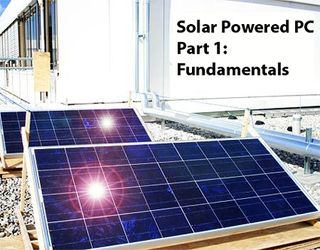Do-It-Yourself Solar-Powered PC: Technical Foundations
Solar-PC: Turning Sunlight Into Computing Power
Even serious PC power junkies eventually understand that a high-performance PC costs some serious money. Over time, what really costs on such rigs is not the individual components but rather, the power such systems consume from the wall socket. A truly awesome system can suck up in excess of $500 a year in electricity. Ever-increasing energy costs, changes in government outlooks, and a new passion for conservation keep upping the ante and the interest in photovoltaic technologies.
All this helps to explain why we've been working our way through an exciting project in our Munich laboratories for the past couple of years: acquisition of solar cells to drive a state-of-the-art PC completely off the grid for continuous 24/7 operation. During this process, we spent weeks in designing and configuring the system you'll learn more about here. But to kick off our discussion of this do-it-yourself project, let's dig into the basics of converting solar power into usable electricity.
Foundations Of Photovoltaic Technology
When it comes to going solar, energy conservation trumps all other concerns, though we did our best to design and deliver a pretty powerful desktop PC. Otherwise, we could simply have driven any of a number of notebook PCs using solar energy without expending too much time or effort on this task. But one of our chief goals in conceiving this article was to base this project on a conventional, state-of-the-art desktop PC intended for everyday use, including a large-format, high-resolution display, reasonable computing performance, and a full-size keyboard.

THG used polycrystalline silicon solar cells for this project
What we must state baldly and clearly from the get-go is pretty dramatic: Our completed solar PC, which automatically compensates for available sunlight, consumes power at peak levels of around 290 Watts. Thus, it should come as no particular surprise that the complete hardware requirements for such a system, including solar components, is not cheap. Nevertheless, we see this as a step into the near future, where our experiment in solar energy delivers an achievable system that can also help propel computer users into an entirely new way of computing - namely, a high-performance, energy-conserving PC that runs entirely on solar power. For under $3,000, you can either spend your money on an ordinary high-end PC, or you can invest in the ultimate form of energy efficiency - an energy conserving, high-powered PC system that works entirely off solar energy.
Join our discussion on this topic
Stay on the Cutting Edge
Join the experts who read Tom's Hardware for the inside track on enthusiast PC tech news — and have for over 25 years. We'll send breaking news and in-depth reviews of CPUs, GPUs, AI, maker hardware and more straight to your inbox.
Current page: Solar-PC: Turning Sunlight Into Computing Power
Next Page Generate Your Own JuiceMost Popular

